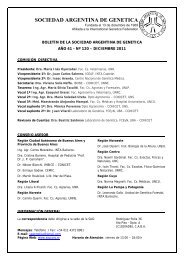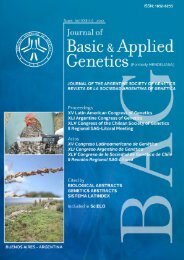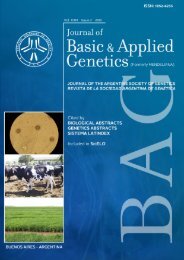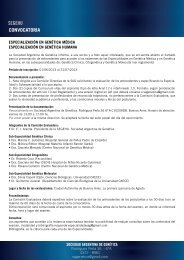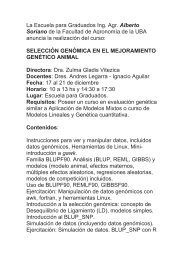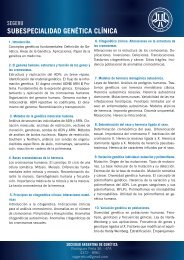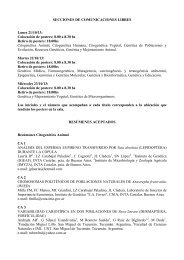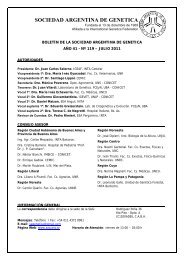BASIC & APPLIED GENETICS - Sociedad Argentina de Genética
BASIC & APPLIED GENETICS - Sociedad Argentina de Genética
BASIC & APPLIED GENETICS - Sociedad Argentina de Genética
- No tags were found...
Create successful ePaper yourself
Turn your PDF publications into a flip-book with our unique Google optimized e-Paper software.
S- 28para avalar inferencias sobre los reor<strong>de</strong>namientos queafectaron los macro y microcromosomas. Adicionalesdatos citogenéticos tanto como hipótesis filogenéticasbasadas en caracteres in<strong>de</strong>pendientes contribuirán acompren<strong>de</strong>r la compleja historia <strong>de</strong> las viboritas <strong>de</strong>dos cabezas.MEIOTIC DRIVE, A UNIFIED EXPLANATIONFOR THE KARYOTYPE MACROCHANGESIN HIGHER FISH GROUPS?Molina WF. Universida<strong>de</strong> Fe<strong>de</strong>ral do Rio Gran<strong>de</strong>do Norte, Centro <strong>de</strong> Biociências, Departamento <strong>de</strong>Biologia Celular e Genética, Campus Universitário,59078-970, Natal – RN, Brasil. molinawf@yahoo.com.br; molinawf@pq.cnpq.brMeiotic drive, the process of preferential chromosomesegregation during meiosis, has been pointed outas responsible for the predominance of certainchromosome types in the karyotypes of mammals,birds and insects. We <strong>de</strong>veloped an extensive analysisof the fixation of mono- or bi-brachial chromosomesin the karyotypes of the large Actinopterygii fishgroup, a key link to the evolution of terrestrialvertebrates, in or<strong>de</strong>r to investigate the generality ofmeiotic drives in <strong>de</strong>termining karyotypic macrotrends.Different from mammals, fishes have markedlyun<strong>de</strong>rgone several types of preferential chromosomalrearrangements throughout evolution. Ten<strong>de</strong>ncies forthe accumulation of mono-brachial chromosomesin Perciformes and Cypriniformes, or bi-brachialchromosomes in Siluriformes and Characiformes,confirm the extension of the centromeric drive theoryof chromosomal evolution also in fishes. Mechanismsof accumulation based on typical centromeric driveor of chromosomes carrying pericentric inversionsare perfectly adjusted to the general karyotypedifferentiation in the principal Actinopterygiior<strong>de</strong>rs. This process is supported by preferentialestablishment of sex chromosomes systems and Bchromosomes in or<strong>de</strong>rs that tend to accumulate bibrachialchromosomes. The mosaic of trends actingat an infra-familiar level could be explained as theinteraction of the directional process of meioticdrive as background, modulated at a smaller scale byadaptive factors or specific karyotypic properties ofeach group, as proposed for the orthoselection mo<strong>de</strong>l.LA CITOGENÉTICA DE PECES EN ARGEN-TINA: UN INDICADOR APLICADO A LABIODIVERSIDADRoncati HA. Cátedra <strong>de</strong> Citogenética General.Depto. <strong>de</strong> Genética. Fac.Cs.Ex.Qcas. y Naturales.Universidad Nacional <strong>de</strong> Misiones (UNaM).Los peces <strong>de</strong> agua dulce representan un 24% <strong>de</strong> labiodiversidad animal y la diversidad morfológica <strong>de</strong>los peces neotropicales es la mayor <strong>de</strong> la ictiofaunaepicontinental mundial, lo mismo ocurre en<strong>Argentina</strong>, siendo la Provincia <strong>de</strong> Misiones hábitat<strong>de</strong> aproximadamente el 50% <strong>de</strong>l total. La mayoría<strong>de</strong> las especies estudiadas fueron colectadas encursos <strong>de</strong> agua <strong>de</strong> las ecorregiones ictiogeográficasMisionera y el Eje Subtropical Potámico el 80% <strong>de</strong>las mismas pertenecen a los Or<strong>de</strong>nes Characiformesy Siluriformes, los que representan también losgrupos <strong>de</strong> mayor abundancia en el Alto Paraná. En<strong>Argentina</strong> la citogenética <strong>de</strong> peces se <strong>de</strong>sarrolló <strong>de</strong>s<strong>de</strong>la década <strong>de</strong> 1980, orientada fundamentalmente aespecies <strong>de</strong> agua dulce. Se han estudiado más <strong>de</strong> 100especies (25 familias, 11 Or<strong>de</strong>nes). Los númeroscromosómicos muestran gran amplitud (2n=36en Astyanax schubarti a 2n=102 en Potamorhinasquamoralevis), observándose que 2n=54, es elnúmero cromosómico diploi<strong>de</strong> modal más frecuente,encontrado principalmente en Characiformes. EnSiluriformes 2n=56 aparece como característico<strong>de</strong> Siluriformes. En los Perciformes se confirmael complemento basal conservativo 2n=48,si bien se han <strong>de</strong>scripto algunas variaciones ennúmero, morfología cromosómica y la presencia<strong>de</strong> microcromosomas. En peces neotropicales esclara la relación entre la diversidad específica y ladiversidad cariotípica, evi<strong>de</strong>nciando la importancia<strong>de</strong> los estudios citogenéticos como indicadores<strong>de</strong> biodiversidad. Como proyección <strong>de</strong>l presentetrabajo se plantean líneas <strong>de</strong> trabajo que integranestos datos con aquellos provenientes <strong>de</strong> análisismoleculares, los que junto a la taxonomía clásicaproveerán elementos para establecer relacionessistemáticas y evolutivas, comparar poblaciones y<strong>de</strong>tectar indicadores relacionados a flujo génico yproducción.COMPREENDENDO A ORGANIZAÇÃOGENÔMICA ATRAVÉS DA CITOGENÉTICAMOLECULARPieczarka JC. Laboratório <strong>de</strong> Citogenética, Instituto<strong>de</strong> Ciências Biológicas, Universida<strong>de</strong> Fe<strong>de</strong>ral doPará. Belém, Pará, Brasil. julio@ufpa.brOs avanços recentes da genômica impactarama análise citogenética. Estudos comparativos <strong>de</strong>seqüências <strong>de</strong> genomas inteiros po<strong>de</strong>m trazer



